Sailboat Rudders Info For PDRacers
Rudders
The rudder on your boat is a very important component, and seems to be one of the biggest problems new builders run into when building PDRacers. There are many types of rudders that can be made, everything from a simple board and stick, to a fancy kickup with tiller linkage & counter weights.
Rudder Blade Size
For the size of the rudder, I haven't seen very many references with calculations on exactly how big they should be made. The only rule of thumb I have heard, is that the submerged area of a leeboard needs to be 4% of the sail area, and the submerged area of the rudder is half the size of the leeboard.
Types of Rudders
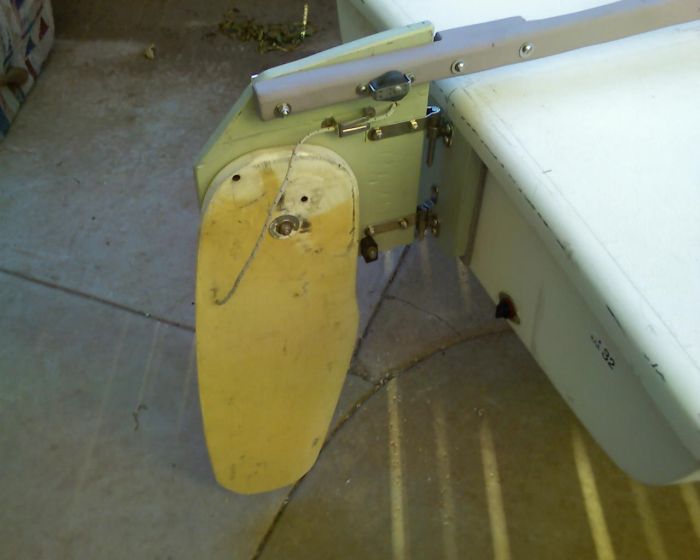
Michalak Kickup Rudder
Made famous by the boat designer Jim Michalak, this is the most popular type of rudder used on small homemade boats. While it may (at first) appear rather ugly, the simplicity of how to build it, and it's ability to easily kickup make it an excellent choice to use.
When sailing away from the beach, you simply release the pendant line and the blade drops by itself. Its OK if it drags a little, the blade will drop all the way down as soon as you get into water deep enough. When returning to the beach, the blade will pivot up by itself as you land. It really is a "set and forget" type of rudder.
It is simply a piece of plywood with pintles bolted on. The blade pivots down and has a stopper. The blade shown in the picture is a fiberglass one so it sinks by itself, but if using a wooden board you will want to melt lead into the end of the blade to make it sink.
More pictures of the kickup rudder
How to melt led - bottom of leeboard page
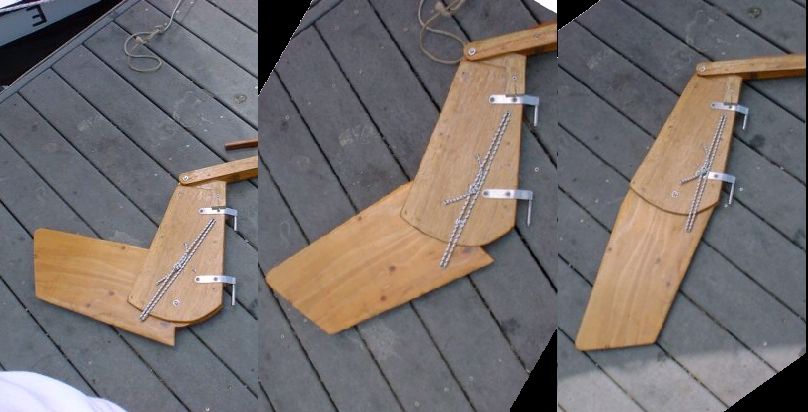
"Sandwich" Kickup Rudder
This is Ken Abrahams's sandwich type kickup rudder. It has a blade that is sandwiched between 2 other boards, with a pivot bolt through the sandwich layers and the blade. Many commercial rudders are made this way, only most of them use aluminum for the sandwich, and fiberglass for the blade.
Ken uses a bungee cord located strategically so that it will hold the board either up or down. Many other people melt lead into the blade so it drops by gravity. Some others use a wing nut in the pivot bolt, so they can use friction to hold it down.
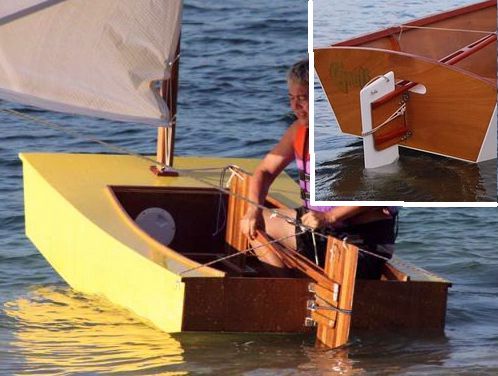
Cassette Rudder
This type of rudder is similar to a sandwich type, only instead of having a pivot bolt, the blade is held into the stock with just a bungee. If you hit something under water, the blade tends to get knocked out so make sure to have it tied to the boat.
This design rudder is intended for deep water use. If used in shallow water, you will need to lift the blade so it does not hit the bottom. The problem is that as you lift the blade up, there is less blade in the water to control the boat, so it becomes less effective. With swing up rudders, the blade continues to stay in the water (albiet in a horozontal position) so you retain full directional control in shallow water.
The other more serious issue is that since the rudder stock is only joined on the leading edge, the stock can split apart under heavy use. To understand better, look at the sandwich rudder stock above, it is joined on the forward edge & top edge to form an L shaped structure holding the stock together, plus has a through bolt holding the blade and sides together.
The tiller is fixed, does not pivot up and down, so when switching from side to side you can't lift it like you can with conventional rudders, so it tends to get in the way.
Mounting the rudder on your boat:
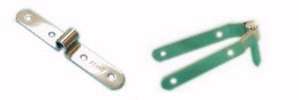
Gudeon and Pintle
These are the hinge parts that hold a rudder onto your boat. The part on the boat is called the gudgeon, and the part on the rudder is called the pintle. Most of the time the pintle has a pin on it, and the gudgeon has the hole, but some times it is the other way around, and sometimes a removable rod holds both together.
There are many types of homemade ones such as shown below, it is a lot of fun to re-purpose parts and build new parts from scratch, but with the rudder hardware, after you break a few of those, I'd highly suggest getting the real marine stuff.
Racelite RL 358 Pintle and Gudgeon Package
Nautos-Laser Rudder Gudgeon Set of 2
Racelite RL 360 Pintle and Gudgeon
Racelite RL 490-S Short Pintle and Gudgeon
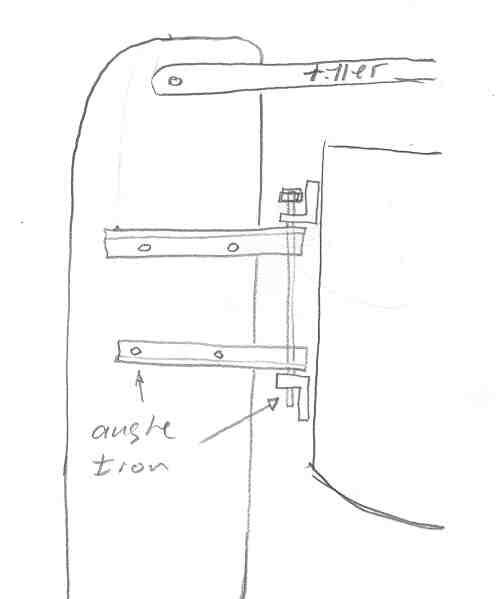
Aluminum Angle Iron
This is a very strong and simple set to make, both the gudgeons and pintles are simple pieces of angle iron. Often made from aluminum angle instead of iron, so it won't rust. You put a piece of all thread rod thru the middle, or a long bolt or shaft.
Here is a great example of it in action: Dan Little #779

Make Your Own
Ken Salvage used a peice of 1/8" x 1" alum FB (hammer bent) and 1 length of alum 1/2" Dia tubing along with some scrap wood 2X2s and misc Hardware. It seems to be strong as the devil and he can get 180 degrees of travel as well. Also mounted Alum FB on the top of the rudder blocks as well.

Door Hinges
With these, you have a block that spaces the hinges off the transom of the boat, so the rudder can fully pivot from side to side. Like it is, the stock is permanently attached to the boat, so for transportation you would remove the blade, or pivot it up for trailering. You can remove the hinge pins and replace them with a smaller shaft that is removable (such as cotter pins) , so you can seperate the rudder stock.
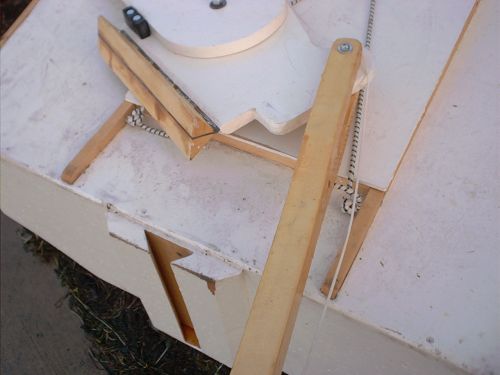
Cary Hinge
This is a simple innovation with 2 key components. First is that instead of using metal hinge parts, the Cary Hinge uses nylon webbing or seat belt strapping has the hinge. The strap is epoxied inside the rudder lamination layers, and also between a wedge shape. Second is the tongue and groove, so you can slide the whole assembly in and out.
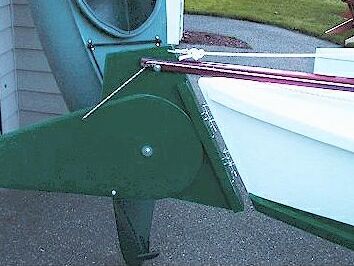
Payson Hinge / Eye Bolts
Made famous by Dynamite Payson, I have seen this method all over the net, seems like lots of people really like the idea of using eye bolts. I think it is so popular because it is such a simple concept, you screw a few eye screws into your rudder stock and a few eye bolts into your transom, then run a big rod thru them.
This is also the design I have heard fails the most. The eye screws don't seem to be able to take the high force put on that area of the boat.
